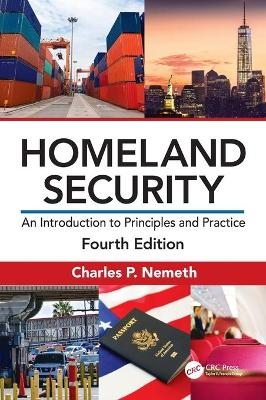
Homeland Security
CRC Press (Verlag)
978-0-367-49441-4 (ISBN)
The new edition is completely updated to reflect changes to both new challenges and continually changing considerations. This includes facial recognition, intelligence gathering techniques, information sharing databases, white supremacy, domestic terrorism and lone wolf actors, border security and immigration, the use of drones and surveillance technology, cybersecurity, the status of ISIS and Al Qaeda, the increased nuclear threat, COVID-19, ICE, DACA, and immigration policy challenges. Consideration of, and the coordinated response, to all these and more is housed among a myriad of federal agencies and departments.
Features
• Provides the latest organizational changes, restructures, and policy developments in DHS
• Outlines the role of multi-jurisdictional agencies—this includes stakeholders at all levels of government relative to the various intelligence community, law enforcement, emergency managers, and private sector agencies
• Presents a balanced approach to the challenges the federal and state government agencies are faced with in emergency planning and preparedness, countering terrorism, and critical infrastructure protection
• Includes full regulatory and oversight legislation passed since the last edition, as well as updates on the global terrorism landscape and prominent terrorist incidents, both domestic and international
• Highlights emerging, oftentimes controversial, topics such as the use of drones, border security and immigration, surveillance technologies, and pandemic planning and response
• Contains extensive pedagogy including learning objectives, sidebar boxes, chapter summaries, end of chapter questions, Web links, and references for ease in comprehension
Homeland Security, Fourth Edition continues to serve as the comprehensive and authoritative text on homeland secuirty. The book presents the various DHS state and federal agencies and entities within the government—their role, how they operate, their structure, and how they interact with other agencies—to protect U.S. domestic interests from various dynamic threats.
Ancillaries including an Instructor's Manual with Test Bank and chapter PowerPointTM slides for classroom presentation are also available for this book and can be provided for qualified course instructors.
Charles P. Nemeth
is a recognized expert in homeland security and a leader in the private security industry, private sector justice, and homeland security education. He has more than 45 book publications and is currently Chair of the Department of Security, Fire, and Emergency Management at John Jay College in New York City.
Dr. Charles P. Nemeth has spent the vast majority of his professional life in the study and practice of law and justice. He is a recognized expert on professional ethics and the justice system, private-sector justice and private security systems. Presently, Dr. Nemeth is Chair and Professor of Security, Fire and Emergency Management and Director of the Center of Private Security and Safety at John Jay College in New York City. He is a prolific writer, having published numerous texts and articles on law and justice throughout his impressive career. His text, Private Security and the Law 4th- (Elsevier, 2012) is considered the foremost treatise on the subject matter. A 5th edition has been published by Taylor/Francis, 2018. His private security expertise is further buttressed by: Private Security and Investigative Process 4th edition (CRC Press, 2019); Private Security: Principles and Practice (CRC Press, 2019l Criminal Law 2nd (CRC Press, 2012) and Law and Evidence 2nd (Jones and Bartlett, 2010). In the area of Homeland Security, he has published Introduction to Homeland Security: Practices and Principles 3rd edition (CRC Press, 2010, 2014, 2017). A 4th edition is planned for 2020. Dr. Nemeht has also authored a series of philosophical works on Thomas Aquinas including: Aquinas on Crime (St. Augustine’s Press, 2010); Aquinas in the Courtroom (Praeger/Greenwood Press, 2001); Aquinas and King: A Discourse on Civil Disobedience (Carolina Academic Press, 2011) and Cicero and Aquinas: A Comparative Study of Nature and the Natural Law (Bloomsbury Publishing, 2018). He has also served as Chief Editor to a peer reviewed journal- The Homeland Security Review since 2005 and currently serves as Chief Editor for the Law, Ethics and Jurisprudence series to be published by Anthem Press. Dr. Nemeth has been an educator for more than 40 years. He holds memberships in the New York, North Carolina and Pennsylvania Bars. Dr. Nemeth was previously a Chair at the State University of New York at Brockport and California University of PA- one of Pennsylvania's 14 State Universities. Dr. Nemeth is a much-sought-after legal consultant for security companies and a recognized scholar on issues involving law, professional ethics and morality and the impact of privatization on public justice models. Dr. Nemeth resides in Pittsburgh, Pennsylvania with his spouse, Jean Marie, together for 48 years and blessed with seven children all of whom are accomplished personally and professionally.
Preface
Acknowledgements
Author
Introduction
Chapter 1 The Idea and Origin of Homeland Security
1.1 Introduction
1.2 Threats to the Homeland: Twentieth-Century Military Movements
1.3 Threats to the Homeland: The Cold War Experience
1.4 Threats to the Homeland: Iran, Terror and the World Stage
1.5 Threats to the Homeland: North Korea: An Old and New Enemy in the War on Terror
1.6 Threats to the Homeland: Revolution, Riot, and Rightful Demonstration
1.6.1 Domestic Terrorism: Pre-9/11
1.6.2 International Terrorism: Pre-9/11
1.7 Conclusion
Keywords
Discussion Questions
Practical Exercises
Chapter 2 Terror, Threat, and Disaster Post 9/11: A New Paradigm of Homeland Security
2.1 Introduction
2.2 Genesis of DHS
2.3 DHS: 2001–2003
2.3.1 Evolution and Change in DHS
2.4 Reorganization and Evolution of DHS: 2003–2015
2.5 DHS In the Age of President Donald J. Trump: 2016-2021
2.5.1 Office of the Secretary of DHS
2.5.2 DHS Directorates
2.5.2.1 Cybersecurity and Infrastructure Security Agency (CISA): Former Directorate for National Protection and Programs
2.5.2.2 Directorate for Science and Technology
2.5.2.3 Directorate for Management
2.5.3 DHS Offices: Support and Operational Components
2.5.4 Agencies and Entities Swept into DHS
2.5.4.1 U.S. Coast Guard
2.5.4.1.1 US Coast Guard Auxiliary
2.5.4.2 U.S. Secret Service
2.5.4.3 Federal Law Enforcement Training Center
2.5.5 Advisory Panels and Committees
2.6 Conclusion
Keywords
Discussion Questions
Practical Exercises
Chapter 3 Homeland Security Law, Regulations, and Budgeting
3.1 Introduction
3.2 Homeland Security Law, Regulations, and Executive Orders
3.2.1 Executive Order 13228: Origin of DHS
3.2.2 Executive Order 12231: Protection of Infrastructure
3.2.3 Executive Order 13233: September 14, 2001
3.2.4 Executive Order 13493 of January 22, 2009
3.2.5 Executive Order 13567 of March 7, 2011
3.2.6 Executive Order 13846 of August 6, 2018
3.2.7 Homeland Security Act of 2002
3.2.7.1 Homeland Security Act and Posse Comitatus
3.2.8 USA Patriot Act: USA Freedom Act of 2015
3.2.9 Specialized Laws
3.2.9.1 REAL ID Program
3.2.9.2 Office of Biometric Identity Management (Formerly Office of US-VISIT)
3.2.9.3 Chemical Facilities
3.2.9.4 Invention and Technology: The SAFETY Act
3.3 Budgeting, Finance, and Funding in Homeland Security
3.3.1 Budget Year: 2003
3.3.2 Budget Year: 2004
3.3.3 Budget Year: 2005
3.3.4 Budget Year: 2006
3.3.5 Budget Year: 2007
3.3.6 Budget Year: 2008
3.3.7 Budget Years: 2009–2010
3.3.8 Budget Years: 2011–2012
3.3.9 Budget Year: 2013
3.3.10 Budget Year: 2014
3.3.11 Budget Year: 2015
3.3.12 Budget Year: 2016
3.3.13 Budget Year: 2017
3.3.14 Budget Year: 2018
3.3.15 Budget Year: 2019
3.3.16 Budget Year: 2020
3.4 Conclusion
Keywords
Discussion Questions
Practical Exercises
Chapter 4 Risk Management, Threats, and Hazards
4.1 Introduction
4.2 Risk Management
4.2.1 The Nature of Risk
4.2.2 Risk Assessment
4.2.3 CARVER+Shock Assessment Tool
4.3 Threats and Hazards
4.3.1 Concept of Threat and Hazard
4.3.2 Weapons of Mass Destruction
4.3.2.1 Nuclear
4.3.2.2 Radiological
4.3.2.3 Biological
4.3.2.3.1 Anthrax
4.3.2.3.2 Plague
4.3.2.3.3 Smallpox
4.3.2.4 Chemical
4.3.2.4.1 Ricin
4.3.2.4.2 Nerve Agents
4.3.2.5 Improvised Explosive Devices
4.4 Computer Security and Information Infrastructure
4.4.1 Cyber Challenges and the American Electoral Process
4.4.2 National Cyber Security Division
4.4.3 US-CERT: Computer Emergency Response Team
4.5 Private Sector and Homeland Security
4.6 Conclusion
Keywords
Discussion Questions
Practical Exercises
Chapter 5 Training and Exercises in Homeland Security
5.1 Introduction
5.2 Grants and Training
5.3 Center for Domestic Preparedness
5.4 Emergency Management Institute
5.5 Homeland Security Exercise and Evaluation Program
5.6 Lessons Learned: Best Practices (LLIS.GOV)/Homeland Security Digital Library (HSDL)
5.7 Community Emergency Response Teams
5.8 National Incident Management System
5.9 Conclusion
Keywords
Discussion Questions
Practical Exercises
Chapter 6 DHS Challenges: National versus State and Local, National Security versus Homeland Security
6.1 Introduction
6.2 Challenge of National Policy at the State and Local Levels
6.2.1 Structure at the State Level
6.2.2 Structure at the Local Level
6.2.2.1 Fusion Centers
6.2.3 Funding and Local Initiatives
6.3 Fine Line of National Defense and Homeland Security
6.3.1 Department of Defense and Homeland Security
6.3.2 Intelligence Gathering and Sharing
6.3.2.1 Office of Naval Intelligence
6.3.2.2 Air Force Intelligence
6.3.2.3 U.S. Marine Corps
6.3.2.4 U.S. Army
6.3.2.5 United States Coast Guard Intelligence
6.3.3 Specialized Military/Defense Units Dedicated to Homeland Security
6.3.3.1 National Maritime Intelligence-Integration Office (NMIO)
6.3.3.2 National Reconnaissance Office
6.3.3.3 Weapons of Mass Destruction Civil Support Teams
6.4 Conclusion
Keywords
Discussion Questions
Practical Exercises
Chapter 7 FEMA, Response, and Recovery
7.1 Historical Foundation for FEMA
7.1.1 Federal Emergency Management Agency: Pre-9/11
7.1.2 Federal Emergency Management Agency: Post-9/11
7.2 FEMA and Preparedness
7.2.1 Role of Mitigation in the Preparedness Model
7.3 FEMA Response and Recovery
7.3.1 National Response Framework
7.4 Conclusion
Keywords
Discussion Questions
Practical Exercises
Chapter 8 Intelligence
8.1 Introduction
8.2 Intelligence
8.3 Terror, Threats, Disaster, and Intelligence Agencies
8.3.1 Federal Bureau of Investigation
8.3.1.1 Joint Terrorism Task Forces
8.3.1.2 National Security Branch
8.3.1.3 NSB and the WMD Directorate
8.3.2 Central Intelligence Agency
8.3.2.1 Directorate of Analysis
8.3.2.2 Directorate of Operations: Clandestine Services
8.3.2.3 Directorate of Science and Technology
8.3.2.4 Directorate of Digital Innovation
8.3.2.5 Directorate of Support
8.3.2.6 Mission Centers
8.3.3 Offices of the Director of National Intelligence
8.3.3.1 National Counterterrorism Center
8.3.3.2 National Counterintelligence and Security Center
8.3.3.3 National Intelligence Council
8.3.4 Defense Intelligence Agency
8.4 Conclusion
Keywords
Discussion Questions
Practical Exercises
Chapter 9 Border Security, U.S. Citizenship, and Immigration Services
9.1 Introduction
9.2 U.S. Customs and Border Protection
9.2.1 Border Protection
9.2.1.1 Secure Border Initiative: Its Creation and Demise
9.2.1.2 CBP Air and Marine
9.2.2 CBP and the Facilitation of Trade and Commerce
9.2.2.1 Cargo
9.2.2.1.1 Secure Freight Initiative
9.2.2.1.2 Container Security Initiative
9.2.2.1.3 Customs–Trade Partnership against Terrorism
9.2.2.1.4 Automated Commercial Environment
9.3 U.S. Citizenship and Immigration Services
9.3.1 Current Challenges in Immigration.
9.3.1.1 Sanctuary Jurisdictions
9.3.1.2 The DACA Dilemma
9.3.1.3 The Visa Lottery Program
9.3.1.4 The Complexity of Chain Migration
9.3.2 Project Shield America Initiative
9.3.3 Fugitive Operations Program
9.3.4 Cornerstone Initiative
9.3.5 Cyber Crimes Center
9.3.6 US-VISIT Program/Office of Biometric Identity Management
9.4 Conclusion
Keywords
Discussion Questions
Practical Exercises
Chapter 10 Transportation Security
10.1 Introduction
10.2 Transportation Security Administration
10.2.1 TSA and the Privatized Airport
10.2.2 Federal Air Marshals
10.2.3 Federal Flight Deck Officers
10.2.4 Law Enforcement Officers Flying Armed
10.2.5 TSA’s Canine Explosive Detection Unit
10.2.6 Risk Management Programs
10.2.7 TSA Technology and Innovation
10.2.7.1 Trace Portals and Their Demise
10.2.7.2 Millimeter Wave/Advanced Imaging Technology
10.2.7.3 Biometrics
10.2.7.3.1 Biometric Application: The Trusted Traveler Program
10.2.7.3.2 TSA Paperless Boarding Pass
10.3 Maritime Security
10.3.1 National Strategy for Maritime Security
10.3.2 Other Maritime Plans
10.3.2.1 National Plan to Achieve Maritime Domain Awareness
10.3.2.2 Maritime Transportation System Security Plan
10.3.3 DHS: Borders and Marine Division
10.3.4 Role of the Coast Guard in Maritime Security
10.3.4.1 Emergency Safety
10.3.4.2 Security and Law Enforcement
10.3.4.3 Cargo and Ports
10.3.4.3.1 Operation Homeport
10.3.4.3.1.1 Port and Harbor Facilities
10.3.4.3.1.2 Container Inspection
10.3.4.3.1.3 Vessel Inspection
10.4 Rail and Mass Transit
10.4.1 Representative Security Programs for Rail and Transit
10.4.1.1 Amtrak
10.4.1.2 CSX: The Freight Line
10.4.1.3 SEPTA: Rail Mass Transit
10.5 Conclusion
Keywords
Discussion Questions
Practical Exercises
Chapter 11 Homeland Security and Public Health
11.1 Introduction: Public Health and Homeland Security
11.2 Water and Public Health
11.3 Agriculture, Food and Public Health
11.3.1 Strategic Partnership Program on Agroterrorism
11.3.2 Infectious Animals
11.3.3 Infectious Diseases, Bioterrorism and Public Health
11.3.3.1 Project BioShield
11.3.3.2 Strategic National Stockpile
11.3.3.3 National Select Agent Registry Program
11.4 Pandemic Threats and Public Health
11.4.1 COVID-19: The Pandemic from China
11.4.2 Planning, Preparedness, and Response to the Pandemic
11.4.3 Response and Recovery under COVID-19
11.5 Conclusion
Keywords
Discussion Questions
Practical Exercises
Chapter 12 The Future of Homeland Security
12.1 Introduction
12.2 Growth without Reason
12.3 Curbing Expansionism in Mission
12.4 The Merits of Decentralization
12.5 The Rise of Technology
12.6 The Need for a New Way of Thinking: Jump Out of the Box
Keywords
Discussion Questions
Practical Exercises
Appendix A
Appendix B
Appendix C
Appendix D
Appendix E
Index
| Erscheinungsdatum | 27.07.2021 |
|---|---|
| Zusatzinfo | 14 Tables, color; 104 Line drawings, color; 379 Halftones, color; 483 Illustrations, color |
| Verlagsort | London |
| Sprache | englisch |
| Maße | 178 x 254 mm |
| Gewicht | 1605 g |
| Themenwelt | Naturwissenschaften ► Geowissenschaften ► Geophysik |
| Sozialwissenschaften ► Politik / Verwaltung ► Europäische / Internationale Politik | |
| ISBN-10 | 0-367-49441-8 / 0367494418 |
| ISBN-13 | 978-0-367-49441-4 / 9780367494414 |
| Zustand | Neuware |
| Haben Sie eine Frage zum Produkt? |
aus dem Bereich


